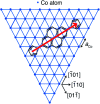Cyclophane with eclipsed pyrene units enables construction of spin interfaces with chemical accuracy
- PMID: 34221324
- PMCID: PMC8221062
- DOI: 10.1039/d1sc01036k
Cyclophane with eclipsed pyrene units enables construction of spin interfaces with chemical accuracy
Abstract
Advanced functionality in molecular electronics and spintronics is orchestrated by exact molecular arrangements at metal surfaces, but the strategies for constructing such arrangements remain limited. Here, we report the synthesis and surface hybridization of a cyclophane that comprises two pyrene groups fastened together by two ferrocene pillars. Crystallographic structure analysis revealed pyrene planes separated by ∼352 pm and stacked in an eclipsed geometry that approximates the rare configuration of AA-stacked bilayer graphene. We deposited this cyclophane onto surfaces of Cu(111) and Co(111) at submonolayer coverage and studied the resulting hybrid entities with scanning tunnelling microscopy (STM). We found distinct characteristics of this cyclophane on each metal surface: on non-magnetic Cu(111), physisorption occurred and the two pyrene groups remained electronically coupled to each other; on ferromagnetic Co(111) nanoislands, chemisorption occurred and the two pyrene groups became electronically decoupled. Spin-polarized STM measurements revealed that the ferrocene groups had spin polarization opposite to that of the surrounding Co metal, while the pyrene stack had no spin polarization. Comparisons to the non-stacked analogue comprising only one pyrene group bolster our interpretation of the cyclophane's STM features. The design strategy presented herein can be extended to realize versatile, three-dimensional platforms in single-molecule electronics and spintronics.
This journal is © The Royal Society of Chemistry.
Conflict of interest statement
There are no conflicts to declare.
Figures






References
-
- Sanvito S. Chem. Soc. Rev. 2011;40:3336–3355. - PubMed
-
- Lazić P. Caciuc V. Atodiresei N. Callsen M. Blügel S. J. Phys.: Condens. Matter. 2014;26:263001. - PubMed
-
- Raman K. V. Appl. Phys. Rev. 2014;1:031101.
-
- Cinchetti M. Dediu V. A. Hueso L. E. Nat. Mater. 2017;16:507–515. - PubMed
-
- Delprat S. Galbiati M. Tatay S. Quinard B. Barraud C. Petroff F. Seneor P. Mattana R. J. Phys. D: Appl. Phys. 2018;51:473001.

